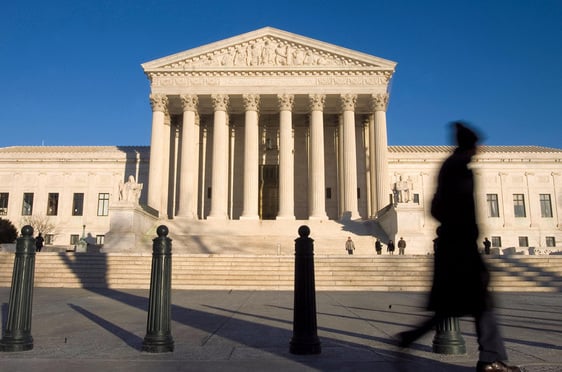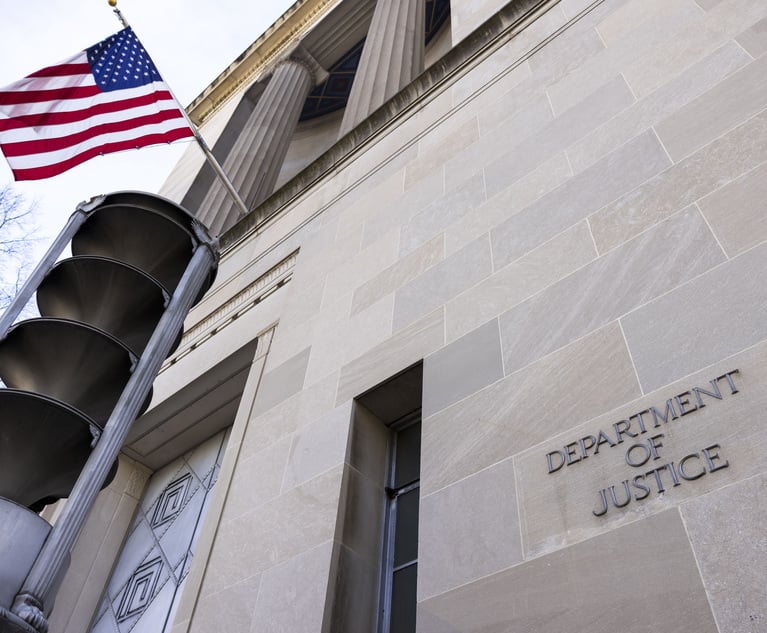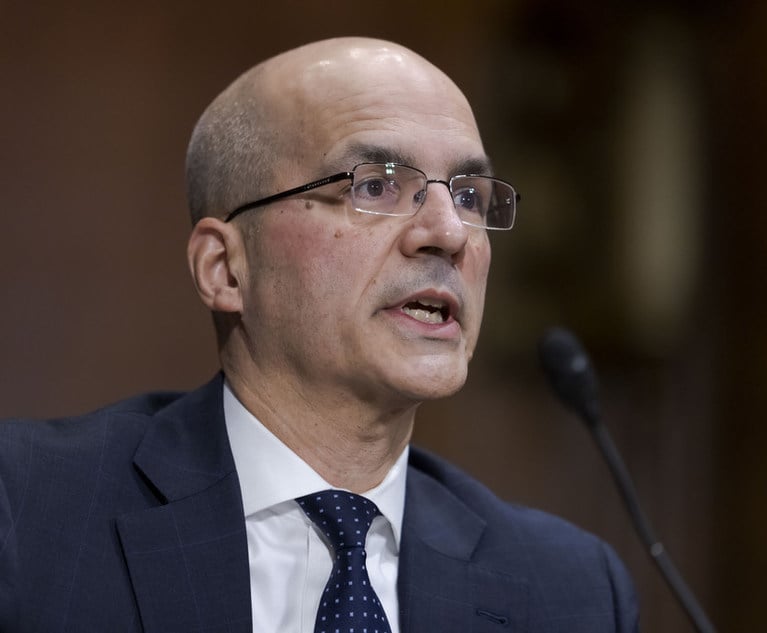Supreme Court Rules That Misstatement From Someone Who Is Not Its 'Maker' Can Still Be Basis of Fraudulent Scheme Claim
The U.S. Supreme Court held today in 'Lorenzo v. SEC' that dissemination of false or misleading statements with an intent to defraud can fall within the scope of Rules 10b-5(a) and (c) of the Securities Exchange Act, as well as the relevant statutory provisions, even if the disseminator did not “make” the statements and consequently falls outside Rule 10b-5(b).
March 27, 2019 at 02:35 PM
4 minute read
 Supreme Court building. Credit: Diego M. Radzinschi/LEGAL TIMES.
Supreme Court building. Credit: Diego M. Radzinschi/LEGAL TIMES.
The U.S. Supreme Court held today in Lorenzo v. SEC, No. 17-1077 (2019), that dissemination of false or misleading statements with an intent to defraud can fall within the scope of Rules 10b-5(a) and (c) of the Securities Exchange Act, as well as the relevant statutory provisions, even if the disseminator did not “make” the statements and consequently falls outside Rule 10b-5(b).
As the director of investment banking in a brokerage firm, petitioner Francis Lorenzo sent two emails about an investment to prospective investors, misrepresenting the value and financial condition of the company. The content of the emails was supplied by the CEO, and the emails were sent “on behalf of” the CEO of the brokerage firm, but they were signed by Lorenzo and encouraged investors to contact him with any questions.
The U.S. Court of Appeals for the District of Columbia Circuit held 2-1 (Justice Brett M. Kavanaugh dissenting) that although Lorenzo was not the “maker” of the statements and could not be held liable under Rule 10b-5(b), the Court's 2011 decision in Janus Capital Group v. First Derivative Traders, 564 U.S. 135, did not bar liability under Rules 10b-5(a) and (c) of the Exchange Act and Section 17(a)(1) of the Securities Act that do not speak in terms of an individual “making” a false statement. The Court held that these provisions encompassed Lorenzo's alleged misconduct, which involved directly sending to investors materially false information with scienter.
Justice Stephen G. Breyer delivered the opinion of the Court, in which Chief Justice John G. Roberts Jr. as well as Justices Ruth Bader Ginsburg, Samuel A. Alito, Jr., Sonia Sotomayor and Elena Kagan joined. Justice Clarence Thomas filed a dissenting opinion joined by Justice Neil M. Gorsuch. (Justice Kavanaugh recused himself from this case.)
The Court rejected the petitioner's narrow interpretation of Rule 10b-5, holding that Rule 10b-5 (a), (b) and (c) necessarily overlap, and conduct similar to Lorenzo's in this case could certainly fall within the ambit of Rule 10b-5 (a) and (c). The Court stated that it is “obvious” that the ordinary meaning of the words in these provisions is sufficiently broad to include within their scope the dissemination of false or misleading information with the intent to defraud. The Court noted that because the defendant sent the emails and understood that they contained material untruths, Lorenzo “employ[ed]” a “device,” “scheme” and “artifice to defraud” within the meaning of subsection (a) of the Rule, Section 10(b) and Section 17(a)(1). By the same conduct, he “engage[d] in a[n] act, practice, or course of business” that “operate[d] … as a fraud or deceit” under subsection (c) of the Rule.
The Court rejected Lorenzo's argument that its holding renders Rule 10b-5(b) “superfluous,” stating that there is “considerable overlap” among the subsections of the Rule and related provisions of the securities laws because at least some conduct that amounts to “employ[ing]” a “device, scheme, or artifice to defraud” under subsection (a) also amounts to “engag[ing] in a[n] act … which operates … as a fraud” under subsection (c). The Court also observed that a contrary conclusion would leave Lorenzo's “plainly fraudulent behavior” outside the Rule's scope even though “using false representations to induce the purchase of securities would seem a paradigmatic example of securities fraud. The Court noted that Janus remains relevant where an individual neither makes nor disseminates false information, provided “that the individual is not involved in some other form of fraud.”
Justice Thomas, writing for the dissent, stated that the Court's holding effectively rendered Janus “a dead letter,” because Lorenzo “undisputedly did not 'make' the false statements under Rule 10b-5(b).”
We anticipate that private plaintiffs will attempt to seize upon this decision to expand potential liability under Section 10(b). While the decision certainly has that potential, there are other rigorous requirements—such as the necessity to plead a strong inference of scienter (intent)—in order to sustain a Section 10(b) claim that should continue to temper such a movement.
Jay Kasner, Scott Musoff, Susan Saltzstein, Colleen Mahoney and Andrew Lawrence are partners at Skadden, Arps, Slate, Meagher & Flom. Mr. Kasner, the firm's national securities litigation practice leader, is one of the country's leading securities, corporate and general commercial litigators. Mr. Musoff serves as the practice leader for the firm's New York litigation practice and also is co-deputy head of the firm's nationwide Securities Litigation Group. Ms. Saltzstein is co-deputy head of the firm's nationwide Securities Litigation Group. Ms. Mahoney heads the firm's Securities Enforcement practice. Mr. Lawrence represents a wide range of clients in investigations by the SEC, the DOJ, other federal and state law enforcement agencies and FINRA.
This content has been archived. It is available through our partners, LexisNexis® and Bloomberg Law.
To view this content, please continue to their sites.
Not a Lexis Subscriber?
Subscribe Now
Not a Bloomberg Law Subscriber?
Subscribe Now
NOT FOR REPRINT
© 2025 ALM Global, LLC, All Rights Reserved. Request academic re-use from www.copyright.com. All other uses, submit a request to [email protected]. For more information visit Asset & Logo Licensing.
You Might Like
View All
'A Shock to the System’: Some Government Attorneys Are Forced Out, While Others Weigh Job Options
7 minute read
'Serious Legal Errors'?: Rival League May Appeal Following Dismissal of Soccer Antitrust Case
6 minute read
How Some Elite Law Firms Are Growing Equity Partner Ranks Faster Than Others
4 minute read
Trending Stories
- 1States Accuse Trump of Thwarting Court's Funding Restoration Order
- 2Microsoft Becomes Latest Tech Company to Face Claims of Stealing Marketing Commissions From Influencers
- 3Coral Gables Attorney Busted for Stalking Lawyer
- 4Trump's DOJ Delays Releasing Jan. 6 FBI Agents List Under Consent Order
- 5Securities Report Says That 2024 Settlements Passed a Total of $5.2B
Who Got The Work
J. Brugh Lower of Gibbons has entered an appearance for industrial equipment supplier Devco Corporation in a pending trademark infringement lawsuit. The suit, accusing the defendant of selling knock-off Graco products, was filed Dec. 18 in New Jersey District Court by Rivkin Radler on behalf of Graco Inc. and Graco Minnesota. The case, assigned to U.S. District Judge Zahid N. Quraishi, is 3:24-cv-11294, Graco Inc. et al v. Devco Corporation.
Who Got The Work
Rebecca Maller-Stein and Kent A. Yalowitz of Arnold & Porter Kaye Scholer have entered their appearances for Hanaco Venture Capital and its executives, Lior Prosor and David Frankel, in a pending securities lawsuit. The action, filed on Dec. 24 in New York Southern District Court by Zell, Aron & Co. on behalf of Goldeneye Advisors, accuses the defendants of negligently and fraudulently managing the plaintiff's $1 million investment. The case, assigned to U.S. District Judge Vernon S. Broderick, is 1:24-cv-09918, Goldeneye Advisors, LLC v. Hanaco Venture Capital, Ltd. et al.
Who Got The Work
Attorneys from A&O Shearman has stepped in as defense counsel for Toronto-Dominion Bank and other defendants in a pending securities class action. The suit, filed Dec. 11 in New York Southern District Court by Bleichmar Fonti & Auld, accuses the defendants of concealing the bank's 'pervasive' deficiencies in regards to its compliance with the Bank Secrecy Act and the quality of its anti-money laundering controls. The case, assigned to U.S. District Judge Arun Subramanian, is 1:24-cv-09445, Gonzalez v. The Toronto-Dominion Bank et al.
Who Got The Work
Crown Castle International, a Pennsylvania company providing shared communications infrastructure, has turned to Luke D. Wolf of Gordon Rees Scully Mansukhani to fend off a pending breach-of-contract lawsuit. The court action, filed Nov. 25 in Michigan Eastern District Court by Hooper Hathaway PC on behalf of The Town Residences LLC, accuses Crown Castle of failing to transfer approximately $30,000 in utility payments from T-Mobile in breach of a roof-top lease and assignment agreement. The case, assigned to U.S. District Judge Susan K. Declercq, is 2:24-cv-13131, The Town Residences LLC v. T-Mobile US, Inc. et al.
Who Got The Work
Wilfred P. Coronato and Daniel M. Schwartz of McCarter & English have stepped in as defense counsel to Electrolux Home Products Inc. in a pending product liability lawsuit. The court action, filed Nov. 26 in New York Eastern District Court by Poulos Lopiccolo PC and Nagel Rice LLP on behalf of David Stern, alleges that the defendant's refrigerators’ drawers and shelving repeatedly break and fall apart within months after purchase. The case, assigned to U.S. District Judge Joan M. Azrack, is 2:24-cv-08204, Stern v. Electrolux Home Products, Inc.
Featured Firms
Law Offices of Gary Martin Hays & Associates, P.C.
(470) 294-1674
Law Offices of Mark E. Salomone
(857) 444-6468
Smith & Hassler
(713) 739-1250






